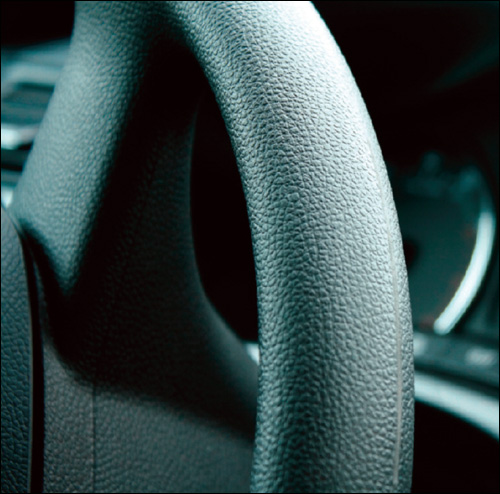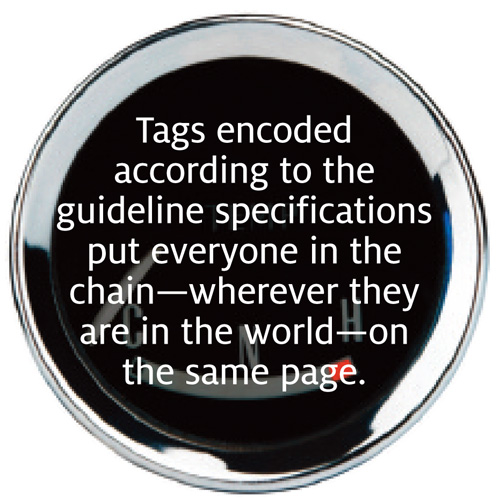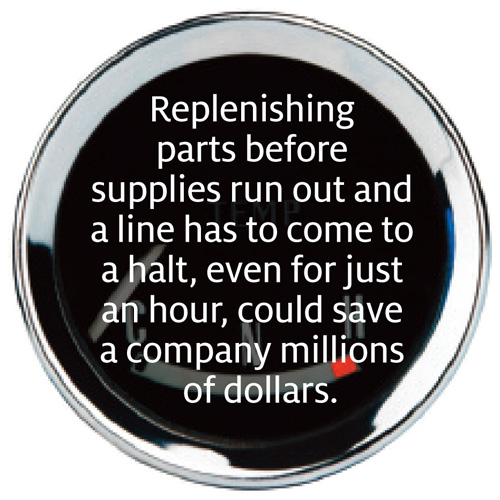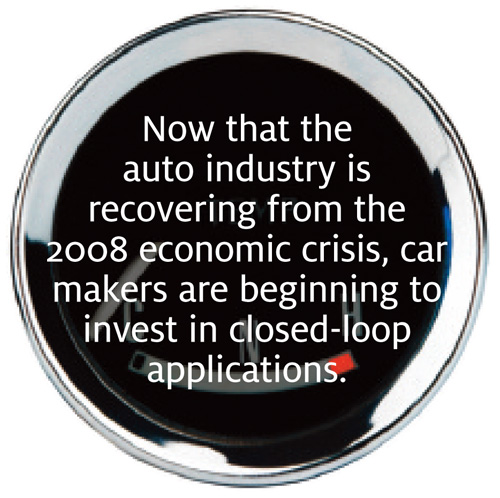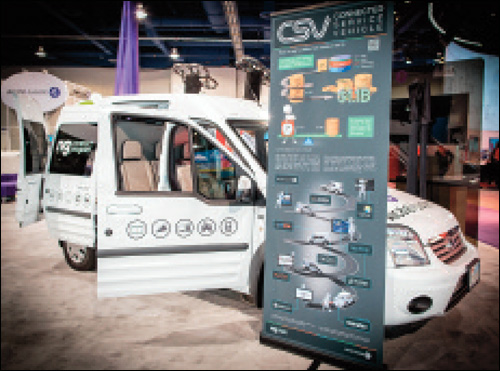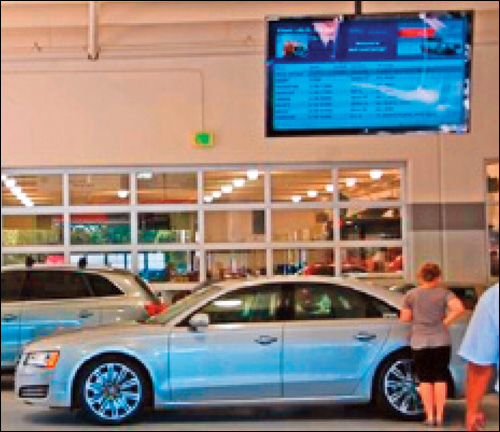Auto-industry players often quip that returnable containers are never lost, just misplaced. But while said in jest, it reveals a hidden truth—actually, a costly problem. Containers can cost thousands of dollars, and studies estimate that the automotive industry spends millions of dollars annually replacing returnable transport items (RTIs), including racks, totes and pallets. In addition, lost or misplaced RTIs carrying essential parts and assemblies can lead to production delays.
To improve RTI tracking, the international Joint Automotive Industry Forum (JAIF)—composed of the United States’ Automotive Industry Action Group (AIAG), Europe’s Odette International, the Japan Automotive Manufacturers Association (JAMA) and the Japan Auto Parts Industry Association (JAPIA)—set out to drive standards into the industry’s supply chain. Closed-loop supply chains exist in the auto market, but many supply chains are open, says Michael Liard, VP of AutoID at VDC Research. “Manufacturers are sourcing materials and goods from various supply-chain partners, and in an open-loop supply chain, standards are critical,” he says.
|
|
In 2011, JAIF published global guidelines for RTI management. They recommend identifying RTIs with EPC Gen 2 ultrahigh-frequency passive RFID tags. They also include rules for storing data on RFID tags so information can be read by bar-code and RFID readers, fed in a common format into diverse back-office systems and shared among parties worldwide.
“You have some expensive containers, boxes and pallets designed to protect parts in transit, and they need to go back to the supplier after the parts are delivered to the customer,” says John Canvin, managing director of Odette International. Tags encoded according to the guideline specifications put everyone in the chain—from the subsuppliers of a supplier to the carmakers themselves, wherever they are in the world—on the same page. “It’s almost the analogy of the mobile cell-phone market,” he says. “There are different makes and service providers in different countries, but they can all speak to each other because of a common format for data exchange and protocols.”
Last year, JAIF published the Global Radio Frequency Identification Item Level Standard, which describes best practices, processes and methods for item identification, verification, traceability, product characteristics and Vehicle Identification Number (VIN) throughout the global automotive supply chain. The goal was to make it possible, at the most fundamental level, for companies to exchange information about part numbers, serial numbers and sources for individual items with the utmost facility.
The Item Level Standard specifies the use of passive or battery-assisted passive RFID tags and the ISO/IEC 18000-63 air-interface protocol. It enables data interchangeability between 2-D optical symbols and RFID systems by prescribing the use of ANSI MH10-based Data Identifiers and ISO or EPC/GS1 standards-based Data Syntax, so there’s minimum impact on IT infrastructures. The use of these standards also is core to achieving data interoperability among companies’ diverse systems, which may use traditional alpha or alphanumeric data identifiers.
“Anytime you have to change software, from an IT standpoint, it’s no longer a minor issue,” says Larry Graham, document editor for the Item Level Standard and principal at consulting firm LG AutoID, and formerly global manager of manufacturing, AIDC and wireless technologies at General Motors. “If we make the data consistent—and the key focus here is on the data—we don’t care about what the media is that carries it. We’ve solved things from the data standpoint.”
Now that standards are in place to facilitate the tracking of RTIs and parts in the global supply chain, the question remains: Will automakers take advantage of them? Meanwhile, RFID continues to make headway in manufacturing operations, and in aftermarket applications.
Agility and Visibility
Automotive manufacturing involves many complicated operations—from ensuring the right parts are at the correct facilities when needed (the standards discussed above should help with this issue) to managing finished vehicles. Car makers first face “a big logistical dance” finding the trailers that have the raw materials they need for production from among the many vehicles making deliveries to their yard, says Adrian Jennings, VP of location technology at Ubisense, an ultra-wideband RFID real-time location system (RTLS) provider. “For many automotive customers, when a trailer comes into the logistics yard, they put our tag on it so they can find it five hours later using our visibility software.”
Then there’s the complexity at every step along the mile-or-so-long assembly line that leads to the finished product. That assembly line has become more complicated as manufacturers consolidate operations so more models can be built on the same line. To further complicate operations, manufacturing runs are smaller, and there’s a trend toward mass customization, so manufacturing lines have to be reconfigured regularly to deal with variations, such as hard or soft tops or optional third-row seating.
At BMW, no two adjacent vehicles coming down the line are the same, because buyers can order any combinations of styles and options they like for their vehicles, Jennings says. There’s a lot of switching up for operators to account for, and a lot of mistakes waiting to be made, he adds.
To facilitate custom assembly, in 2009, Ubisense provided an RTLS solution at the automaker’s Regensburg, Germany, plant. Vehicles and tools are identified with Ubisense RFID tags, and software dictates which tools are used where and how for different cars. This helps BMW avoid problems such as applying the wrong tool-tightening settings to particular models, Jennings says. “We physically prevent the tool from being used with the wrong setting, because we know exactly where it is and what it’s working on,” he says. Based on the project’s success, BMW deployed the solution at its other plants, recently completing the global rollout at its Spartanburg, S.C, facility. (For more details about the RTLS solution, see BMW Finds the Right Tool.)
RFID enables agile manufacturing, says Mark Gallant, VP of industrial marketing at AeroScout. The company, recently acquired by Stanley Black & Decker, offers Wi-Fi-based RFID RTLS solutions for managing mobile assets, to help with tasks such as parts replenishment and vehicle inventory. Many large global auto manufacturers have adopted its solution, Gallant says, because they had already expanded their standard Wi-Fi networks beyond the corporate offices to their plants, a trend AeroScout says it sees gaining momentum. With a Wi-Fi infrastructure already in place, deployment can be quicker and less expensive, and return on investment can be realized faster.
AeroScout battery-powered tags are most frequently attached to work cells, the points on assembly lines where car doors and other parts are added, says Bret Small, VP of technical services. When an operator at a work cell runs low on inventory, a push of a button activates a message that’s sent from the tag along standard wireless access points on the Wi-Fi network. This kicks off a replenishment process in which the tag’s unique ID is associated in a car maker’s enterprise resource planning and warehouse systems with the required parts, and then a delivery cart takes the parts to the appropriate spot on the line. Replenishing parts before supplies run out and a line has to come to a halt, even for just an hour, could save a company millions of dollars.
Manufacturers of commercial vehicles and heavy equipment, such as tractors and seed planters, build bigger items typically in smaller volumes. They also manufacture their products in work cells or departments, rather than on a continuous assembly line. So instead of attaching tags to work cells, it’s more efficient to monitor the physical work-in-process, Small says. That makes it easier to locate each unit and gain actionable business intelligence. “There is a way to see, for example, that a particular planter spent three hours in that cell, when the average time is 2 hours and 20 minutes,” he says. “So it can raise an alert automatically through the system that something is happening—maybe a shortage of parts that’s slowed things down. You can manage by exception automatically.”
RFID-enabled agility extends to the end of the car-manufacturing process. AeroScout’s RTLS technology, affixed to finished vehicles, can deliver the precise location of the 12 cars out of the thousands in storage on a manufacturer’s lot that are scheduled to be shipped to a particular dealer, Gallant says. Workers locate vehicles using a computer or handheld device that lets them view a vehicle’s location on a map, eliminating long searches and increasing productivity.
Volkswagen Slovakia is using Identec Solutions‘ active RFID RTLS at its Bratislava facility to track each vehicle as it enters and exits servicing stations during testing and finishing processes. It helps staff members find vehicles quickly, improve planning and prevent bottlenecks (see Volkswagen Slovakia Gains Efficiency in Its Finishing Process for more details.) Based on the benefits, the auto manufacturer expects this spring to have “a much deeper penetration of the system and a way bigger experience with it,” says Bernward Wenninger, the company’s IT and process manager.
In addition to improving efficiencies, using RFID to manage post-assembly finishing processes can save auto manufacturers money. “The time between a vehicle leaving the end of the inspection process and shipping is cash tied up in inventory,” says Ubisense’s Jennings. “That’s working capital locked up in a vehicle awaiting some kind of repair or rework.” An RTLS solution can turn information gleaned from tracking cars into actionable business intelligence that can address problem issues. “If you halve the time vehicles spend in rework,” he says, “you release 50 percent of the capital tied up there.”
Moving Forward
The three-year RFID-based Automotive Network (RAN) project, which ended in December, was designed to test the use of RFID in seven production and logistics processes in Germany’s auto industry, including sharing supply-chain information using data repositories based on the Electronic Product Code Information Services (EPCIS) standard. Roughly 20 auto manufacturers, suppliers, logistics firms, research institutes, and IT and software companies, including BMW, Daimler and Opel, participated in the RAN project (see Germany’s RFID-based Automotive Network Gets Rolling).
The group, which plans to continue its efforts in 2013, according to Oliver Czech, manager of Daimler’s RFID-based processes, said it met one of its main goals: developing methods, approaches and standards for tagging containers and products with RFID, to enable the real-time exchange of information among supply-chain partners (see RFID-based Automotive Network Project Achieves Its Goals).
Some of the participating automakers have announced plans to continue using—and, in some cases, expanding—RFID applications within their own facilities. Now that the auto industry is recovering from the 2008 economic crisis, car makers are beginning to invest in closed-loop applications. U.S. car makers are investigating RFID technology, but they are keeping their pilots close to the vest. When it comes to open-loop applications that involve supply-chain partners, “I would say the uptake is slow, but nevertheless it is growing,” Odette International’s Canvin says.
As part of the RAN project, Daimler successfully exchanged information with partners regarding the locations of tagged metal carriers for motors being transported between two countries, and the car maker plans to continue testing the RFID-based tracking system. Robert Bosch GmbH, which manufactures automotive components, participated in a pilot involving the exchange of RTIs with one of its parts suppliers and automaker Opel. It is moving some applications into production and continuing to test others. It is also working to launch replenishment processes with RTI suppliers.
The efforts of JAIF and RAN are on a course to intersect: JAIF intends to set up an Automotive Business Vocabulary that extends the existing EPCIS Core Business Vocabulary, and RAN plans to work with the German Association of the Automotive Industry (VDA) on RFID standardization. Since VDA is a member of Odette, and Odette is part of JAIF, “we have a direct interest in establishing the best solution for all parties,” Canvin says, noting the current VDA, Odette and JAIF standards for RFID are all aligned around ISO.
While GS1 has done a lot of useful work with EPCIS, their processes are focused on the production and distribution of general consumer goods, including food, Canvin says, and don’t reflect the specific requirements of the automotive industry. “Together, we want to define the events useful for our industry and ‘translate’ them into the EPCIS language,” he says.
Ultimately, education is key to getting all auto-industry players to embrace supply-chain applications. Projects like RAN that demonstrate RFID’s benefits in the open automotive supply chain are critical.
“The JAIF RFID team did a lot of proactive work in engaging ISO to craft the global automotive Returnable Transport Items standard and the Item Level standard,” LG AutoID’s Graham says. “The harder work is ahead to drive implementation.”
The Connected Service Vehicle
In 2008, Ford Motor Co. partnered with RFID firm ThingMagic (now a division of Trimble) and toolmaker DeWalt to develop Tool Link, an RFID asset-tracking application. The solution, which was offered as a feature on some pickup trucks and vans, was designed to help contractors make sure they had all the tools they needed before leaving for a job site, and they had everything back on board when they were finished.
Ford is no longer offering the RFID application, which ran on an in-dash computer and featured a built-in RFID reader to identify the tagged tools. The broader system of which it was a part was pulled when Ford ran into production issues around elements unrelated to the RFID component, says Bernd Schoner, VP of business development at ThingMagic.
But the concept was sound, so ThingMagic is updating the application. While data capture (reading tagged assets) still resides on the vehicle, data management is moving from the vehicle to the cloud. This way, the data is available for use by a variety of applications and can be accessed by vehicle operators as well as managers who need to monitor assets.
Telcom companies, for example, have thousands of service vehicles, and each must have onboard the tools needed to fix whatever problems the tech encounters. “They are very well organized around what that inventory should be, but not good at making sure it’s actually there,” Schoner says. “RFID is a great tool to essentially monitor the inventory on a utility vehicle and make sure the tech actually has everything he needs when he goes out.”
The Connected Service Vehicle, developed by the ng Connect Program, was demonstrated in January at the 2013 CES show in Las Vegas. Founded by Alcatel-Lucent, ng Connect is composed of more than 190 members, including network and consumer electronics companies, and application and content providers. The Connected Service Vehicle showcases cloud-based services that deliver office productivity to vehicle-based workers. As part of the concept vehicle, the ThingMagic Mercury6 RFID reader will be used to support work-order-based inventory-management and tool-tracking applications. Uploading asset information from the vehicle to a central data aggregation layer for anywhere, anytime consumption, Schoner says, “is the future.”
Audi Connects With Consumers
Audi has turned to RFID to build cars more efficiently (see Audi Uses Semi-Passive Tags to Make TTs). Now, Audi of America believes the technology will help its dealerships build better relationships with their customers. Ten of its dealerships piloted the RFID MyDealerLot (MDL) solution in 2012, and other locations are due to join the project this year.
MDL enables Audi dealerships to provide more personalized service when customers arrive for auto maintenance or repairs. To identify customers and their vehicles, a passive RFID tag is placed on the back of a car’s rearview mirror, and RFID readers are installed at key points around a facility. Service staff can greet guests by name, and the solution checks them in automatically. Customers’ cars also can be tracked anywhere on the property, even through a car wash, so service advisors can keep guests informed of their cars’ status.
“For Audi customers, in particular, time is the most important commodity,” says Audi of America service operations analyst Dan Rider. “The more efficiently customers can get in and out of their dealer, and the more personal the experience, the better. RFID technology enables this to be executed seamlessly.”
But Audi is betting that in addition to improving customer relations, MDL will help boost sales. When a customer drives onto the service lot, the person who sold that individual the car also is notified, so he or she can greet the guest and reinforce the relationship. That’s helpful when it comes time for the customer to buy a new car and sell the old one as part of the process, says MDL founder and CEO George Cresto. “They do business with you today, you know the history of their vehicle, and you can get them out of their existing vehicle and into a new one,” he says. “That is the name of the game in the auto industry—keeping a customer for life.”
That’s exactly what’s happening at a Coral Springs Audi dealership that has deployed MDL. “By simply keeping the relationship alive and greeting the customer,” Rider says, they’ve sold some people new cars when they come in for service. It’s little wonder he believes RFID technology will become “one of the core fundamental pieces of our service process. We are continuously striving to be at the cutting edge of technology, both in vehicles and in our dealership experience.”

